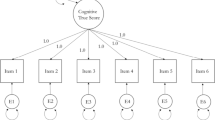Abstract
It is shown that replacement of the zero diagonal elements of the symmetric data matrix of approximate squared distances by certain other quantities in the Young-Householder algorithm will yield a least squares fit to squared distances instead of to scalar products. Iterative algorithms for obtaining these replacement diagonal elements are described and relationships with the ELEGANT algorithm (de Leeuw 1975; Takane 1977) are discussed. In “large residual” situations a penalty function approach, motivated by the ELEGANT algorithm, is adopted. Empirical comparisons of the algorithms are given.
Similar content being viewed by others
References
DE LEEUW, J. (1975), “An Alternating Least Squares Approach to Squared Distance Scaling,” Unpublished manuscript, Department of Data Theory, University of Leiden.
GOWER, J. C. (1966), “Some Distance Properties of Latent Root and Vector Methods Used in Multivariate Analysis,”Biometrika, 53, 325–338.
GOWER, J. C. (1984), “Multivariate Analysis: Ordination, Multidimensional Scaling and Related Techniques,” inHandbook of Applicable Mathematics, Volume VI: Statistics, Part B, ed. E. Lloyd, Chichester: Wiley, 727–781.
JORESKOG, K. G. (1977), “Factor Analysis by Least Squares and Maximum Likelihood Methods,” inStatistical Methods for Digital Computers, eds. K. Enslein, A. Ralston and H. Wilf, New York: Wiley, 125–153.
NATHANSON, J. A. (1971), “An Application of Multivariate Analysis in Astronomy,”Applied Statistics, 20, 239–249.
SCHIFFMAN, S. S., REYNOLDS, M. L., and YOUNG, F. W. (1981),Introduction to Multidimensional Scaling, New York: Academic Press.
SCHONEMANN, P. H. (1970), “Fitting a Simplex Symmetrically,”Psychometrika, 35, 1–21.
TAKANE, Y. (1977), “On the Relations Among Four Methods of Multidimensional Scaling,”Behaviormetrika, 4, 29–43.
TAKANE, Y., YOUNG, F. W., and DE LEEUW, J. (1977), “Nonmetric Individual Differences Multidimensional Scaling: An Alternating Least Squares Method with Optimal Scaling Features,”Psychometrika, 42, 7–67.
TORGERSON, W. S. (1958),Theory and Method of Scaling, New York: Wiley.
YOUNG, F.W. (1982), “Enhancements in ALSCAL-82,” inProceedings of the Seventh Annual SAS User's Group International Conference, Cary, NC: SAS Institute Inc., 633–642.
YOUNG, G., and HOUSEHOLDER, A. S. (1938), “Discussion of a Set of Points in Terms of Their Mutual Distances,”Psychometrika, 3, 19–22.
Author information
Authors and Affiliations
Additional information
An early version of this paper was presented at the Multidimensional Data Analysis Workshop, Pembroke College, Cambridge, July 1985. I want to thank Jan de Leeuw and Yoshio Takane for bringing the ELEGANT algorithm to my attention and for clarifying its rationale and notation. My thanks go also to Stephen du Toit for help with the ALSCAL computations reported in Section 7.
Rights and permissions
About this article
Cite this article
Browne, M.W. The Young-Householder algorithm and the least squares multidimensional scaling of squared distances. Journal of Classification 4, 175–190 (1987). https://doi.org/10.1007/BF01896985
Issue Date:
DOI: https://doi.org/10.1007/BF01896985




